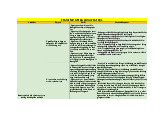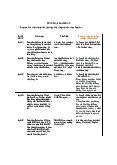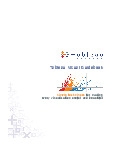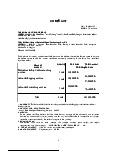



















Preview text:
See discussions, stats, and author profiles for this publication at: https://www.researchgate.net/publication/337967233
Predicting intraday jumps in stock prices using liquidity measures and technical indicators
Preprint · December 2019 CITATIONS READS 0 1,983 3 authors, including: Ao Kong R. Azencott
Nanjing University of Finance and Economics University of Houston
12 PUBLICATIONS58 CITATIONS
189 PUBLICATIONS2,427 CITATIONS SEE PROFILE SEE PROFILE
Some of the authors of this publication are also working on these related projects: Idiosyncratic View project
Machine Learning to Study fMRI Recordings of Brain Activity View project
All content following this page was uploaded by Ao Kong on 27 May 2020.
The user has requested enhancement of the downloaded file.
Predicting intraday jumps in stock prices using
liquidity measures and technical indicators Ao Kong*
School of Finance, Nanjing University of Finance and Economics, Nanjing 210023, China Hongliang Zhu
School of Management and Engineering, Nanjing University, Nanjing 210023, China Robert Azencott
Department of Mathematics, University of Houston, TX 77204, USA Abstract
Predicting the intraday stock jumps is a significant but challenging problem in
finance. Due to the instantaneity and imperceptibility characteristics of intra-
day stock jumps, relevant studies on their predictability remain limited. This
paper proposes a data-driven approach to predict intraday stock jumps using the
information embedded in liquidity measures and technical indicators. Specif-
ically, a trading day is divided into a series of 5-minute intervals, and at the
end of each interval, the candidate attributes defined by liquidity measures and
technical indicators are input into machine learning algorithms to predict the
arrival of a stock jump as well as its direction in the following 5-minute interval.
Empirical study is conducted on the level-2 high-frequency data of 1271 stocks
in the Shenzhen Stock Exchange of China to validate our approach. The result
provides initial evidence of the predictability of jump arrivals and jump direc-
tions using level-2 stock data as well as the effectiveness of using a combination
of liquidity measures and technical indicators in this prediction. We also re-
veal the superiority of using random forest compared to other machine learning
algorithms in building prediction models. Importantly, our study provides a
portable data-driven approach that exploits liquidity and technical information
from level-2 stock data to predict intraday price jumps of individual stocks.
Preprint submitted to Journal of Forecasting December 10, 2019 Keywords:
Intraday stock jumps, High-frequency data, Liquidity measures,
Technical indicators, Machine learning 1. Introduction
Stock price jumps refer to large discontinuous changes in the path of stock
returns and are mainly associated with company-specific events, market news
announcements or large arbitrage hedging activities (Merton, 1976; Lee, 2008;
Boudt and Pertitjean, 2014). Compared with continuous price changes, stock
jumps bring higher risk, leading to different applications in risk management,
option pricing and asset allocation. While various studies of stock jumps, such
as jump detection, causes of jumps, jump modelling and the effect of jumps
on the market, have attracted much attention(Lee, 2008; Evans, 2011; Lee and
Mykland, 2012; Boudt and Pertitjean, 2014; Huang, 2018; Ma et al., 2019),
research on the predictability of stock jumps, especially under the intraday
scenario, is very limited. This limitation might be because stock jumps normally
occur instantly with imperceptible precursors, which makes it very challenging
to capture the predictive features before their arrival. This study thus attempts
to complement the literature in this area by designing an approach to predict
intraday stock jumps and testing the method on thousands of stocks in a Chinese stock market.
To design a mechanism for jump prediction, statistically significant jumps in
stock prices must be detected accurately. Most jump identification methods are
designed for low-frequency data, which can only identify the existence of jumps
within a day. Recent development of volatility modelling with high-frequency
price series promotes advanced methods to detect the intraday timing of jump
arrivals(Lee, 2008; Boudt et al., 2011), which enables the analysis of the instant
ex ante transaction behaviour of stocks.
Based on these intraday jump detection algorithms, some studies have in-
vestigated the intraday liquidity dynamics and found significant abnormal move-
ments before stock jumps(Boudt and Pertitjean, 2014; Wan et al., 2017; B¸edowska- 2
S´ojka, 2016). Although some of the liquidity measures have proved to be as-
sociated with the occurrence of stock jumps, they perform poorly in predicting
stock jumps individually. While all these studies concentrated on only single
variables, the question of whether combinations of liquidity measures have high-
er explanatory power in predicting stock jumps remains open.
Different from liquidity measures, technical indicators, originating from tech-
nical analysis for stock investing, characterize the market situation in an alter-
native way: a liquidity measure describes the market quality at the curren-
t time, whereas a technical indicator studies the market movement within a
comparably longer time window. Although initially designed for analysing low-
frequency stock data, technical indicators have been successfully used to predict
high-frequency stock price series in recent literature(Son et al., 2012; Sun et al.,
2019; Borovkova and Tsiamas, 2019). However, to the best of our knowledge,
no study has been performed to analyse their predictive power for stock jumps.
Therefore, this study intends to combine both liquidity measures and tech-
nical indicators to predict intraday stock jumps. Our proposed approach is
based on level-2 high-frequency data, which are ultra informative for tracking
the instant movement of these attributes before stock jumps. We divide a whole
trading day into a series of 5-minute intervals, and at the end of each interval,
our model determines whether a stock jump will occur in the next 5 minutes.
Ten types of liquidity measures and eighteen types of technical indicators are
adopted to define hundreds of candidate attributes that characterize the cur-
rent and prior market dynamics of each interval. Since the predictive power of
a single attribute is very weak, various combinations need to be analysed with
a large quantity of data to search for potential important patterns indicating
the arrival of stock jumps. Our prediction model is built and tested universally
on the data of 1271 stocks in Chinese stock exchange to avoid overfitting issues.
Such a task is too complicated for a human observer; hence, machine learning
is used in our prediction owing to the advances in addressing high-dimensional
datasets and complex modelling problems.
The main contributions of our work are as follows: 3
1) We propose an approach to predict intraday stock jumps using level-2 high-
frequency data. To the best of our knowledge, only two studies (M¨akinen
et al., 2019; Zheng et al., 2013) consider the prediction of individual stock
jumps. While Zheng et al. (2013) focused on two specific types of jumps,
called inter-trade and trade-through price jumps, we concentrate on a more
general price jump defined by Merton (1976). M¨akinen et al. (2019) studied
the same price jump as us, but used tick-by-tick data and focused only on
five individual stock. In some countries such as China, tick data is not
available to the public. Besides, tick data is substantially affected by market
microstructure noise and should be used cautiously(Jiang and Lo, 2011). As
a result, our methodology is based on the level-2 high-frequency data of 1271
stocks in China and relies on a different set of processing algorithms.
2) Our approach combines the explanatory power of liquidity measures and
technical indicators to enhance intraday stock jump prediction. On one
hand, liquidity measures have been examined only individually concerning
their predictive power for price jumps, while combinations of them have been
ignored; on the other hand, no technical indicator has been studied regarding
the occurrence of jumps, given that such indicators have been successfully
used to predict stock prices in existing literatures.
3) Apart from predicting the arrival of intraday stock jumps, our study sheds
additional light on the predictability of jump directions. M¨akinen et al.
(2019) have studied a similar problem, but obtained pessimistic results, while
we proved in this study that the jump direction can be predicted with better
result using our constructed features and model construction scheme. 2. Literature Review 2.1. Price jump detection
Early studies on price jumps normally use daily data and treat volatility
and its jump component as unobservable hidden variables that are modelled by
GARCH-jump or SV-jump models. Such methods involve uncertain pre-setting 4
of parameter forms and complex parameter estimation, which obstructs the
accurate estimation of price jumps. With the accumulation of high-frequency
data, Abdersen and Bollersleve (1998), Abdersen et al. (2001) and Barndorff-
Nielsen and Shephard (2002) introduced ”estimated volatility” calculated from
the sum of squared high-frequency returns, thereby explicitly representing and
modelling financial volatility. Barndorff-Nielsen and Shephard(2004, 2006) fur-
ther used the difference between the realized volatility and the bipower variation
as an unbiased estimator of discrete jump variance, giving a nonparametric test
(BNS test) for jump detection. Such a nonparametric method avoids complex
parameter setting, leading to higher jump detection efficiency. Since then, the
BNS method has been further improved using various forms of variation and
volatility (Huang and Tauchen, 1976; Jiang and Oomen, 2008; Merton, 2009;
Ait-Sahalia and Jocad, 2009; Mancini, 2009; Corsi et al., 2010; Podolskij and
Ziggel, 2010; Andersen et al., 2012).
However, the above BNS type methods can only determine whether a jump
occurs within a trading day, without specifying the time and number of the
jumps. To solve this problem, Abdersen et al. (2007) designed a test (ABD test)
for intraday jump detection that compares the standardized intraday returns to
critical values from the normal distribution. However, Lee (2008) found that the
ABD test is too permissive and proposed a more general test (LM test) using
critical values from the limit distribution of the maximal test statistic. Boudt
et al. (2011) further demonstrated that the accuracy and robustness of the LM
test can be improved by considering the intra-week periodicity in volatility.
These methods are normally applied to 5-minute interval data. Alternatively,
Lee and Mykland (2012) and Christensen et al. (2014) proposed two methods
to identify price jumps from ultra high-frequency data at tick frequency since
they believe identification is aided by the finest resolution of price data. The
spurious detection by their methods was further eliminated by Bajgrowicz et al.
(2016) using an explicit thresholding technique.
The finest tick-by-tick resolution preserves sufficient information but induces
higher market microstructure noise, which biases the jump detection. Although 5
determining the optimal sampling frequency for jump detection is an ongoing
research topic, Liu et al. (2015) found little evidence that the consensus 5-
minute interval is surpassed by any other choice of sampling frequency in terms
of realized volatility estimation. A similar argument was made by Jiang and
Lo (2011) that tick data should be used cautiously because of concerns about
market microstructure effects. Therefore, we base our jump detection procedure
on the consensus 5-minute sampled data.
2.2. Liquidity dynamics before price jumps
Individual stock jumps are associated with not only macroeconomic events
but also sudden firm-specific news (Lahaye et al., 2011; Bollerslev et al., 2008;
Lee, 2008). In addition, recent research by Boudt and Pertitjean (2014) and
B¸edowska-S´ojka (2016) found that pure liquidity variation might be the main
reason for a large majority of individual stock jumps. Regardless of the causes
of jumps, scientists tend to discover clues before the arrival of stock jumps from
a market microstructure perspective since macro variables appear to have weak
forecasting power (Jiang and Lo, 2011; B¸edowska-S´ojka, 2016).
Boudt and Pertitjean (2014) found a substantial phenomenon of abnormal
liquidity dynamics before stock jumps and noted that some liquidity measures,
such as order imbalance and depth imbalance, are informative for price discov-
ery, especially after the arrival of news. Similar results in the T-bond market
were obtained by Jiang and Lo (2011), who compared the capacity of macroe-
conomic news announcements versus liquidity shocks to explain price jumps
and found that the latter has more explanatory power, even during the prean-
nouncement period. B¸edowska-S´ojka (2016) analysed the pattern of liquidity
measures around price jumps on the Warsaw Stock Exchange and summarized
that jumps are accompanied by abnormalities in some liquidity variables, such
as trading volume, number of transactions, volatility, and market depth.
While the majority of works is devoted to the analysis of developed markets,
Wan et al. (2017) focused on the Chinese stock market and observed, based
on a large number of jumps, that liquidity measures show abnormal patterns 6
around jumps. Moreover, in contrast to other developed countries, the Chinese
government does not release new data and policies at a fixed time interval, and
no data suppliers provide estimations of news expectations and surprises to the
public. Thus, in the Chinese stock market, prices may gradually adjust to news
announcements. As in other similar markets with random news announcement
dates, we may therefore conjecture that clues about jumps in liquidity mea-
sures may be more significant than those in developed markets. Although some
liquidity measures are found to be abnormal before price jumps, it remains un-
clear whether combinations of liquidity variables have higher prediction power,
despite the weak power of individual variables.
2.3. Technical indicators in high-frequency data prediction
Technical indicators, developed for over a century, are commonly used anal-
ysis tools to determine the market trend of an asset using historical price and
volume information. Although technical indicators were originally designed for
low-frequency data, typically daily data, a number of efforts have been made
to explore their capacity in forecasting high-frequency intraday financial da-
ta. Notably, technical indicators contribute to intraday stock trend prediction
whenever the sampling frequency is by tick(Tanaka-Yamawaki and Tokuoka,
2007), minutes(Son et al., 2012) or hours(Gunduz et al., 2017).
Tanaka-Yamawaki and Tokuoka (2007) examined the effectiveness of several
frequently used technical indicators, such as momentum, moving average and
relative strength index, for several-tick-ahead trend prediction of NYSE stock
prices. Son et al. (2012) used eight types of technical indicators, including mov-
ing average, price rate of change, and relative strength index, to predict the trend
direction of KOSPI200 index 5 minutes ahead. Gunduz et al. (2017) adopted
more than 20 types of technical indicators to predict the hourly movements
of 100 stocks in Borsa Istanbul. In general, Schulmeister (2009) demonstrat-
ed, over a long period of time, that the profitability of technical indicators has
shifted from daily to intraday as a result of adaption to the increasing speed of stock transactions. 7
The related research is not limited to stock markets. In the work of Nakano
et al. (2018), Ozturk et al. (2016) and Lee et al. (2003), the profitability of
using technical indicators for intraday price prediction is demonstrated in bit-
coin, foreign exchange and index futures markets. Apart from trend prediction,
technical indicators based on high-frequency data are also successfully applied
in various other fields, such as determining optimal trading time(Cervell´o-Royo
et al., 2015), ranking stocks(Wang and Rasheed, 2018) and predicting market shocks(Sun et al., 2019).
Intraday jump is an important component of high-frequency asset series.
Despite achieving satisfactory results in high-frequency data prediction, techni-
cal indicators are rarely used in the analysis of intraday jumps extracted from high-frequency time series. 3. Preliminaries 3.1. Jump detection technique
Our intraday jump detection phase is based on the LM test developed by
Lee (2008). To improve the performance, we combine this technique with the
robust volatility estimation methods proposed by Andersen et al. (2012) and
Boudt et al. (2011), as in the work of (Wan et al., 2017). The choice of working
with 5-minute return series is consistent with many influential studies (Lee,
2008; Jiang and Lo, 2011; Boudt and Pertitjean, 2014, e.g.). Details of the
technique are provided in the following.
A trading day is divided into n of 5-minute intervals, and intraday jumps
within each interval are detected. Let rt,i be the log return in the ith interval
of day t, and let σ2 be the integrated volatility on day t. Lee (2008) estimated t
σ2 by the realized bipower variation of the intraday returns t n 1 X ˆ σ2 = t |r n − 1 t,i−1||rt,i|, (1) i=2 8
and the jump detecting statistic is constructed by r L t,i t,i = . (2) ˆ σt
To improve the robustness of volatility and jump detection, Andersen et al.
(2012) proposed the MedRV estimator ˆ
σmed to estimate the integrated volatility t v u nk u 1 π n X ˆ σmed = t median t √ × {|˜r nK − 2 i−2|, |˜ ri−1|, |˜ri|}, 6 − 4 3 + π nk − 2 i=3 (3)
where {˜ri, i = 1, 2, · · · , nK} are the return series of all the intervals in recent
K days. Here, we choose K = 5 as in Wan et al. (2017). In addition, the
weighted standard deviation (WSD) estimator f W SD of f t,i t,i, suggested by Boudt
et al. (2011), is included as a periodic component to account for the intraweek
periodicity in high-frequency returns. Then, the jump detecting statistic Lt,i is replaced by ˜ r L t,i t,i = . (4) ˆ σmed t f W SD t,i
The final detected jump in the ith interval of day t should satisfy ˜
Lt,i − CnT > −log(−log(1 − α)), (5) SnT
where CnT and SnT are defined by Lee (2008) and T is the total number of days. 3.2. Liquidity measures
Ten liquidity measures are utilized to describe the return, volatility, market
width and market depth of a stock’s trading in each 5-minute interval. Let LM
be any liquidity measure; then, its value computed in the ith interval of day t
is represented by {LMt,i, i = 1, 2, · · · , n, t = 1, 2, · · · , T }, where T is the total
number of trading days. Table 1 summarizes the ten liquidity measures.
Detailed computation of these measures is illustrated in Appendix A. These
measures need standardization to be comparable between different stocks. Simi- 9 Table 1: Liquidity measures Index Name Notation 1 Return rt,i 2 Cumulative return Rt,i 3 Number of trades kt,i 4 Trading volume vt,i 5 Trading size st,i 6 Order imbalance oit,i 7 Depth imbalance dit,i 8 Quoted spread qst,i 9 Effective spread est,i 10 Realized volatility rvt,i
lar to the study of Boudt and Pertitjean (2014), kt,i, vt,i and st,i are standardized
by dividing by the median of their data at the same time of the previous 60 days
and subtracting 1. The rest are standardized by subtracting the median of their
data at the same time of the previous 60 days. 3.3. Technical indicators
Eighteen types of technical indicators are used to characterize the move-
ment of a stock’s price within a prior window. Technical indicators are usually
functions of the open price, highest price, lowest price, close price and vol-
ume. In contrast to daily computation, in the context of our study, this price
and volume information is extracted within each 5-minute interval. The com-
putation of some indicators relies on a few lagged periods, hence the lagged
intervals. Suppose there are T trading days in total; then, there should be
nT intervals. Let q denote the number of lagged intervals. Then, the list of
any intraday technical indicator T I over all the intervals can be represented by
{T I(q)k, k = 1, 2, · · · , nT }. All the indicators are summarized in Table 2.
Detailed computation of these indicators is provided in Appendix B. These
indicators also need to be standardized. M A(q)k, EM A(q)k T Rk, OBVk,
P V Tk, N V Ik and P V Ik are standardized by dividing by the median of their
data at the same time of the previous 60 days and subtracting 1. The rest are
already ratios, so they are standardized by subtracting the median of their data 10




